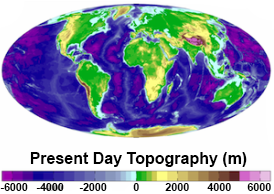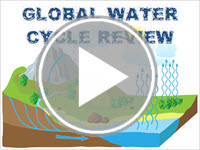
Global Water Cycle
The Water Cycle
 A cycle is series of processes or events that continually repeat in some order. The water cycle, also known as the hydrologic cycle, is a never-ending process that results in the movement of water from one location to another. As water moves throughout the Earth’s surface and atmosphere, it undergoes several phase changes. Water changes phases from solid to liquid to gas as a result of changes in temperature. In this interactivity, you will learn the parts and processes involved with the water cycle. Click the player button to get started.
A cycle is series of processes or events that continually repeat in some order. The water cycle, also known as the hydrologic cycle, is a never-ending process that results in the movement of water from one location to another. As water moves throughout the Earth’s surface and atmosphere, it undergoes several phase changes. Water changes phases from solid to liquid to gas as a result of changes in temperature. In this interactivity, you will learn the parts and processes involved with the water cycle. Click the player button to get started.
View a printable version of the interactivity.
The Water Cycle and Our Planet

Bathymetry and Topography of Earth
A little more than two-thirds (2/3) of the Earth is covered by water, and more than 97 percent of all water is found in the oceans. The remaining three percent is found in glaciers, icecaps, streams, rivers, lakes, ground water, soil moisture, and water vapor in the atmosphere.
![]() How is all of this water maintained on Earth? View this presentation about the water cycle from NOAA. The water cycle is important to many other nutrient cycles such as the nitrogen cycle and phosphorous cycle. Many nutrients are capable of dissolving in water. As water moves through the water cycle, it carries dissolved nutrients with it.
How is all of this water maintained on Earth? View this presentation about the water cycle from NOAA. The water cycle is important to many other nutrient cycles such as the nitrogen cycle and phosphorous cycle. Many nutrients are capable of dissolving in water. As water moves through the water cycle, it carries dissolved nutrients with it.
Global Water Cycle Review
![]()
 Now the you have explored the global water cycle, check your knowledge. In this non-graded interactivity, follow the instructions on each question slide. Click SUBMIT to check your responses. Click the player button to begin.
Now the you have explored the global water cycle, check your knowledge. In this non-graded interactivity, follow the instructions on each question slide. Click SUBMIT to check your responses. Click the player button to begin.


